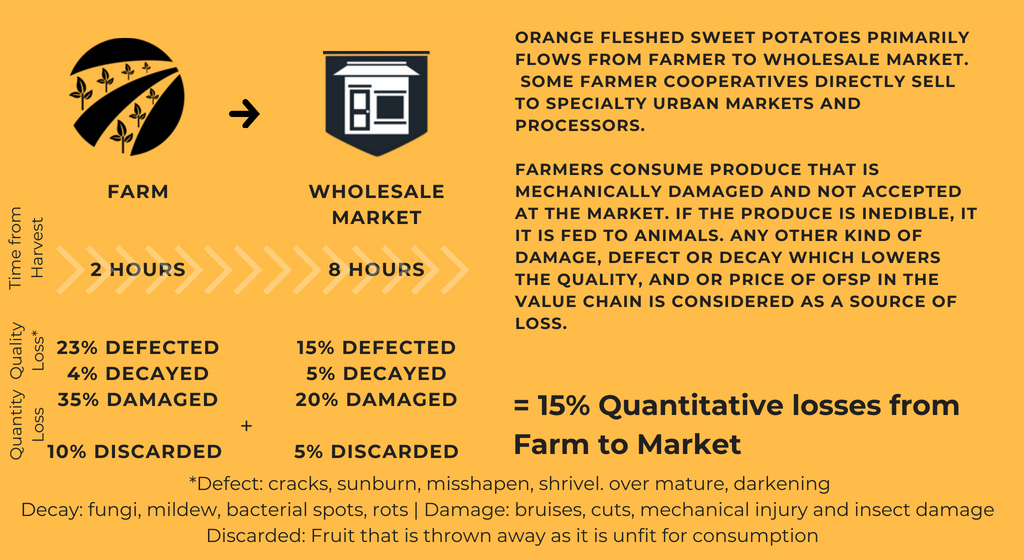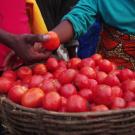This report and policy brief were created by the Horticulture Innovation Lab's project focused on reducing postharvest losses in Rwanda. Through postharvest innovations and interventions, this project works to help farmers and agribusiness enterprises gain better return on investments by adopting appropriate technology and reducing postharvest losses.

Summary of postharvest losses in orange-fleshed sweet potatoes
Orange-fleshed sweet potato (OFSP) is a relatively new crop for Rwanda with two decades of significant support from the NGO community. The crop is primarily grown as a livelihoods and food security crop with a strong nutritional component. The main challenges for OFSP include uncertain market demand and uncertain supply issues for processors, both of which are linked: due to the lack of a local fresh market, farmers may be reluctant to engage in OFSP production, while processors cannot engage in processing without assured supply.
The study found that at the farm level, 22.5 percent of the produce had defects, 3.5 percent was decayed and 35 percent had mechanical damage. On average, 10 percent of the produce was sorted out and consumed at home or used as animal feed (depending on the level of damage). At the wholesale level, 15 percent of the produce had defects, 5 percent had decay and 20 percent had mechanical damage. At the wholesale level, the team observed only one case of 5 percent of the produce being sorted out. To understand the postharvest losses in orange fleshed sweet potato, the project conducted Value Chain Analysis and Commodity Systems Assessment Methodology (CSAM).
OFSP is being grown in 18 districts across the country - Muhanga, Kamonyi, Ruhango, Rulindo, Musanze, Burera, Gakenke, Ngororero, Rwamagana, Gatsibo, Kayonza, Karongi, Rutsiro, Rubavu, Gicumbi, Bugesera, Nyaruguru and Nyamagabe.
Around 70 percent of sweet potatoe growers adopted OFSP and are being supported by the Rwanda Agricultural Board (RAB), International Potato Center (CIP) and other NGOs in the supply of vines and extension services.
Key findings in quality problems and losses for OFSP
Damage during harvest:
-
Traditional hoe harvest techniques can be very damaging. Once cut, if not cured, the tuber becomes more susceptible to degradation and insects.
-
Rough handling
-
Farmer cash flow issues may result in early harvesting, leading to a poor-quality product (immature roots are too fibrous.)
-
Farmers use stagnant water to wash the tubers. This can induce fungal diseases.
Problems from postharvest handling:
-
Rough handling leads to bruised and damaged skin of OFSP. The potatoes are harvested by a hoe that cuts the produce. Workers move the produce from one point to the other on the field while sorting, loading, unloading and transport on their heads. Handling damage lowers the shelf life.
-
Weevil and other pest infestation due to cracking.
Issues from storage practices:
-
Low use of adapted “curing.”
-
Farmers use traditional practices such as storing in the ground or covered by grass, that have potential to cause damage and require assessment.
-
A CIP model storage solution (zero energy) was made of brick to protect against theft and was therefore expensive.
Problems related to transportation:
-
Accidents on bikes or while carrying loads on heads are common
-
Distance to travel is far and hilly terrain increases difficulties with transport
Postharvest report methodology
To understand the postharvest losses in orange fleshed sweet potato, the project conducted Value Chain Analysis and Commodity Systems Assessment Methodology (CSAM).
Postharvest losses were measured using a modified Commodity Systems Assessment Methodology (CSAM). The CSAM is a methodology for describing and evaluating the planning, production, postharvest handling and marketing of agricultural commodities. The modified CSAM includes interviews of stakeholders, observations of handling practices, and direct measurements of quality and quantity losses throughout the value chain.
A value chain analysis was completed in order to identify constraints. The analysis was completed using interviews with key actors, site visits, and a literature review.

